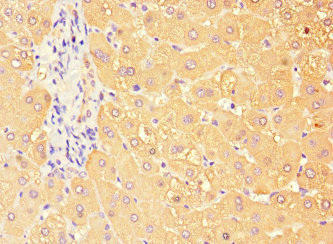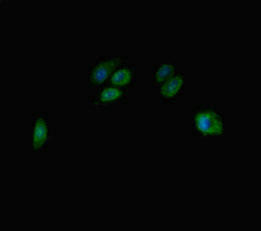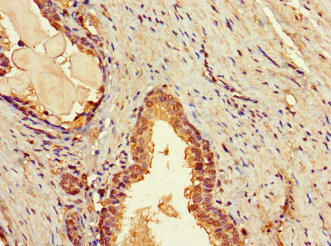Description
| Antibody Name: | TBC1D7 Antibody (PACO47090) |
| Antibody SKU: | PACO47090 |
| Size: | 50ug |
| Host Species: | Rabbit |
| Tested Applications: | ELISA, IHC, IF |
| Recommended Dilutions: | ELISA:1:2000-1:10000, IHC:1:20-1:200, IF:1:50-1:200 |
| Species Reactivity: | Human |
| Immunogen: | Recombinant Human TBC1 domain family member 7 protein (1-293AA) |
| Form: | Liquid |
| Storage Buffer: | Preservative: 0.03% Proclin 300 Constituents: 50% Glycerol, 0.01M PBS, PH 7.4 |
| Purification Method: | >95%, Protein G purified |
| Clonality: | Polyclonal |
| Isotype: | IgG |
| Conjugate: | Non-conjugated |
 | Immunohistochemistry of paraffin-embedded human liver tissue using PACO47090 at dilution of 1:100. |
 | Immunofluorescent analysis of HepG2 cells using PACO47090 at dilution of 1:100 and Alexa Fluor 488-congugated AffiniPure Goat Anti-Rabbit IgG(H+L). |
 | Immunohistochemistry of paraffin-embedded human prostate tissue using PACO47090 at dilution of 1:100. |
| Background: | Component of the TSC-TBC complex, that contains TBC1D7 in addition to the TSC1-TSC2 complex and consists of the functional complex possessing GTPase-activating protein (GAP) activity toward RHEB in response to alterations in specific cellular growth conditions. The small GTPase RHEB is a direct activator of the protein kinase activity of mTORC1 and the TSC-TBC complex acts as a negative regulator of mTORC1 signaling cascade by acting as a GAP for RHEB. Participates in the proper sensing of growth factors and glucose, but not amino acid, , by mTORC1. It is unclear whether TBC1D7 acts as a GTPase-activating protein and additional studies are required to answer this question. |
| Synonyms: | TBC1 domain family member 7 (Cell migration-inducing protein 23), TBC1D7, TBC7 |
| UniProt Protein Function: | TBC1D7: a putative GTPase activating protein for Rab family protein(s).Protein type: GAPs; GAPs, RabChromosomal Location of Human Ortholog: 6p24.1Cellular Component: cytoplasmic vesicleMolecular Function: GTPase activator activity; protein binding; Rab GTPase bindingBiological Process: negative regulation of TOR signaling pathway; positive regulation of protein ubiquitinationDisease: Macrocephaly/megalencephaly Syndrome, Autosomal Recessive |
| UniProt Protein Details: | |
| NCBI Summary: | This gene encodes a member of the TBC-domain containing protein family. The encoded protein functions as a subunit of the tuberous sclerosis TSC1-TSC2 complex which plays a role in the regulation of cellular growth and differentiation. Mutations in this gene have been associated with autosomal recessive megalencephaly. Alternative splicing results in multiple transcript variants. Naturally occurring readthrough transcription occurs between this locus and downstream LOC100130357. [provided by RefSeq, Jan 2016] |
| UniProt Code: | Q9P0N9 |
| NCBI GenInfo Identifier: | 37538019 |
| NCBI Gene ID: | 51256 |
| NCBI Accession: | Q9P0N9.1 |
| UniProt Secondary Accession: | Q9P0N9,Q2TU37, Q53F44, Q5SZL7, Q86VM8, Q96MB8, E7EV96 |
| UniProt Related Accession: | Q9P0N9 |
| Molecular Weight: | 28,509 Da |
| NCBI Full Name: | TBC1 domain family member 7 |
| NCBI Synonym Full Names: | TBC1 domain family member 7 |
| NCBI Official Symbol: | TBC1D7 |
| NCBI Official Synonym Symbols: | TBC7; MGCPH; PIG51 |
| NCBI Protein Information: | TBC1 domain family member 7 |
| UniProt Protein Name: | TBC1 domain family member 7 |
| UniProt Synonym Protein Names: | Cell migration-inducing protein 23 |
| Protein Family: | TBC1 domain family |
| UniProt Gene Name: | TBC1D7 |
| UniProt Entry Name: | TBCD7_HUMAN |






